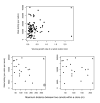Aging in a long-lived clonal tree
- PMID: 20808953
- PMCID: PMC2923084
- DOI: 10.1371/journal.pbio.1000454
Aging in a long-lived clonal tree
Abstract
From bacteria to multicellular animals, most organisms exhibit declines in survivorship or reproductive performance with increasing age ("senescence"). Evidence for senescence in clonal plants, however, is scant. During asexual growth, we expect that somatic mutations, which negatively impact sexual fitness, should accumulate and contribute to senescence, especially among long-lived clonal plants. We tested whether older clones of Populus tremuloides (trembling aspen) from natural stands in British Columbia exhibited significantly reduced reproductive performance. Coupling molecular-based estimates of clone age with male fertility data, we observed a significant decline in the average number of viable pollen grains per catkin per ramet with increasing clone age in trembling aspen. We found that mutations reduced relative male fertility in clonal aspen populations by about 5.8 x 10(-5) to 1.6 x 10(-3) per year, leading to an 8% reduction in the number of viable pollen grains, on average, among the clones studied. The probability that an aspen lineage ultimately goes extinct rises as its male sexual fitness declines, suggesting that even long-lived clonal organisms are vulnerable to senescence.
Conflict of interest statement
The authors have declared that no competing interests exist.
Figures


Comment in
-
We all gotta go sometime.PLoS Biol. 2010 Aug 17;8(8):e1000455. doi: 10.1371/journal.pbio.1000455. PLoS Biol. 2010. PMID: 20808954 Free PMC article. No abstract available.
References
-
- Finch C. E. Longevity, senescence, and the genome. Chicago: University of Chicago Press; 1990.
-
- Stewart E. J, Madden R, Paul G, Taddei F. Aging and death in an organism that reproduces by morphologically symmetric division. PloS Biol. 2005;3:e45. doi: 10.1371/journal.pbio.0030045. - DOI - PMC - PubMed
-
- Munné-Bosch S. Do perennials really senesce? Trends Plant Sci. 2008;13:216–220. - PubMed
-
- Roach D. A. Evolutionary senescence in plants. Genetica. 1993;91:53–64.
-
- Eckert C. G. The loss of sex in clonal plants. Evol Ecol. 2002;15:501–520.
Publication types
MeSH terms
LinkOut - more resources
Full Text Sources
Other Literature Sources

